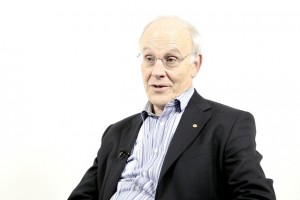Gravity
Cosmologist Sergei Odintsov on Newton's law, modifications of general relativity, and the essence of gravity
Quantum biology and quantum effects in biology has become a very important topic in the last 20 years. What is the main question related to quantum biology and to quantum effects in molecules? When you have molecules, essentially, they have a function – most of them have an important function. For example, enzymes can be used in our body to accelerate some reactions. The key question is: «How can molecule achieve its functions?».
Usually, it is via simple processes, such as ligating to another molecule, releasing energies. Up to now, in the last century, people have been accepting that most of these effects were driven by essentially classical physics, typically by the large-scale effects only involving temperature, solvent, and many atoms. Quantum physics was never really involved in this kind of phenomena. There has been a slight change of thinking around that in the last 20 years. In particular, when people realize that there are simple phenomena, which cannot be understood if you do not involve very specific quantum effects.
Quantum physicists wanted to solve this first question starting with the simplest possible explanation so we essentially tried to model the iron binding to oxygen. The service is typically a classical state, meaning that you can picture your electron, put a position in space; they behave like classical objects and you have a transfer of charge from iron to oxygen. This resulted in calculations for which we did all the maths and everything else.
Afterward, we asked a second question, which is related to that hemoglobin, is also known to bind to another molecule – carbon monoxide. You might know that carbon monoxide is toxic. The reason why carbon monoxide is toxic – is that hemoglobin binding to oxygen-II, on one hand, versus hemoglobin binding to carbon monoxide, on the other hand, results in a very slight imbalance of energy towards carbon monoxide. So carbon monoxide sticks to hemoglobin, which inhibits the respiration function. If carbon monoxide sticks to hemoglobin, hemoglobin cannot bind to oxygen-II – which is what you want in your body to breathe. Carbon monoxide is toxic because of that. So imbalance in energy is very small. So going back to my story physicists tried to do the calculations. What we actually find is that there is a very large imbalance towards carbon monoxide – a 20,000 times larger chance to bind to carbon monoxide than oxygen-II.
If this was true there would be no way we could breathe, isn’t it so? So, this actually drove many questions and actually, we started in the 80s. Since the1980s and since then people have been trying to solve this puzzle. How can we explain why hemoglobin binds to carbon monoxide and oxygen-II in the right proportion?
This is a simple question but was a three-decade-long mystery. So quantum physicists try to address this problem. It’s a very interesting, I would say, event because biology and quantum physics were so far very independent communities, but with the more and more advances of both fields, people realized that there might be things we could share. They may be thinking: «which developments done in quantum physics could apply to biology?» and vice-versa. So there have been more and more discussion across these two communities – interesting ideas emerge and some of the ideas actually were stemming from the field of high-temperature superconductivity which has nothing to do at all with quantum biology and with haemoglobin but some of the ideas developed to understand superconductivity were also applied to quantum biology and especially to the simple problem of haemoglobin.
By doing the calculations involving quantum physics where essentially your electrons are not really only in one position in space (in quantum physics your electrons are in different positions in space at the same time which is a slightly strange phenomena) but using these simple ideas which we know is true for atoms at very small temperature, in haemoglobin, we actually realize that you can correct the calculations. What you find, is that hemoglobin and the iron atom are essentially in a very strong quantum state that is as electrons, which don’t really have a given position in space but are delocalized. This was a very new surprising result. Change a bit the way how you might see hemoglobin.
It’s surprising in many regards because, if hemoglobin is a quantum molecule – it has different positions in space at the same time, it is not how we picture blood, isn’t it? We know that we are not quantum objects at the microscopic scale; we all have a given position in space. So, of course, this only applies to the small kernel of hemoglobin which is consisting of a few atoms, typically 20 atoms, so with a very localized quantum effect but because hemoglobin only binds to oxygen-II at this very specific location while you have iron plus a few atoms around. This is a very well localized action, if you want, which involves just a few atoms and which can sustain quantum effects, such as binding to oxygen-II, whether your electrons at these scales are delocalized everywhere and a quantum. It was interesting to understand that in some simple example like that, quantum effects are important.
You might say: «Well, it’s not very important because at the end of the day I know what hemoglobin is and I know what is doing». But this quantum effect has significant consequences in real life. If I change the binding energy to a ligand, such as oxygen to carbon monoxide, we change the energetics of your molecule – and this is a real quantity, which is something you can measure and test.
The interest to understand photosystem-II is not just to understand photosynthesis. The idea is that if we can understand photosynthesis, we might have a perfect way to absorb light artificially in an artificial complex that we could use application. That is actually what we call a biomimicking when you mimic the chemistry or physics of a plant of the biological complex in a lab, such that you can apply to something else. Photosystem-II is another system that people have not yet understood and where there is a strong belief that quantum effect will definitely be very important to explain the mechanism of how you actually convert light to electrons and how this electrons hole pair can move in the compound. With the whole range of phenomena that you could think of, where quantum effects are important in biology, some of these complexes and most of these complexes, we believe, will involve transition metal ions. Typically this would be iron, manganese, zinc. So we have an idea where quantum effects might be important in this system. So the biological molecule involving this transition ion is usually the one having an important function, which is quite interesting. There’s a whole range of molecules and if you look at them the important ones, which are very active and do something very specific, involve these atoms.
There’s a philosophical question behind it which is actually: «How does nature know why it should choose iron in hemoglobin to achieve that particular function?». It’s a bit of reverse engineering – you can imagine that if you replace iron with something else, with, for example, zinc or manganese – could you achieve the same function? What the calculations have shown is that most likely – no, you will not achieve the same function if you replace iron in hemoglobin, for example, with manganese. You would get completely different functions and you will not be able to bind to oxygen-II. There is a very clever way that nature has found to use quantum physics in an efficient way to achieve a given function and this is a topic emerging now in science combining biology with quantum physics.

Cosmologist Sergei Odintsov on Newton's law, modifications of general relativity, and the essence of gravity

Biologist Arkhat Abzhanov on morphological changes among birds, transgenes, and laboratory experiments on chic...

Nobel Prize laureate David Gross on Rutherford experiments, asymptotic freedom, and the origin of the particle...